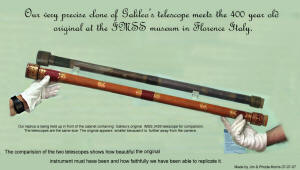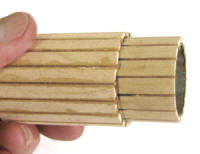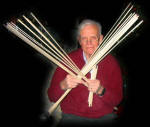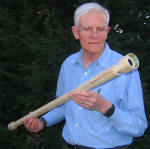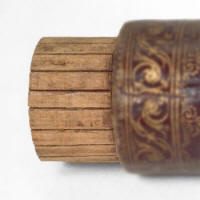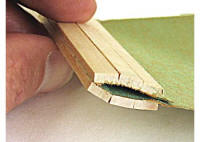|
Construction
Details of Galileo's Telescope Tube and Lens
Holders.
Studying Galileo's
Telescope in detail disclosed a unique
resin
composite construction. It is
not made of cardboard and paper as is often reported in the
literature This discovery gave us the opportunity to study
the methods and philosophy of construction available to and
generated by Galileo, his associates, and assistants in
their scientific and engineering work. This work has raised
some interesting academic and replica questions. 1.Was it
designed for "mass production" by non skilled labors? 2, was
the eyepiece lens the only part replace or was the lens
holder also changed? Studying the original in some detail
has helped us in our mission to construct a much more
faithful reproduction inside and out of this famous Galileo
telescope for the Griffith Observatory.
As mentioned
earlier we were very fortunate in addition to our
measurements and photographs of this beautiful Galilean
telescope to also have access to excellent pictures taken
before and after a recent restoration. These pictures showed
that the internal construction of the telescope is not of
cardboard and paper but of wood and in a most novel way.
This opened to us a very rare opportunity of making a very
fine replica in the most complete and accurate detail even
to the interior. This accuracy of course helps to show the
inventiveness and creativity of how scientist worked in
1600. It shows along with its history the on going issues
and struggle of the basic research scientist trying to get
support for their research and acceptance of its results.
This telescope and its history shows ----Not only the
technical aspects of science ---- but the politics of
funding for basic research work, of the struggles in
convincing others to see the world more clearly from a
scientific measurement point of view. This telescope served
as a political tool as well as a discovery tool. It was
designed to impress people not of science but of power and
wealth by the richness of its decorative appearance. it was
also preformed well, 20 power, to show them his discoveries.
The data we collected were
vital in making a truly faithful replication of both inside
and the outside of this remarkable telescope. Many if not
all replicas of this telescope in the past have not had this
opportunity or not felt it worth while to go beyond the use
of cardboard, plastic or metal tubes and turned solid wood
lens holders none of which were used in the original
instrument. Some have had to replicate the telescopes
without accurate data thus included in some cases serious
errors in their replication. We believe that this is
unfortunate and scales down the broadness and richness of
what is to be learned from this telescope. We feel, perhaps
unfairly, that the lack of detail and authenticity only
increases the myopic view for some of what science is all
about.
Below we show you
the detail of the very elegant mode of
construction and the amount of detailed work that was
required to make it.*
|
